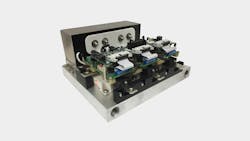Automakers Will Never See Semiconductors the Same Way
For decades, automakers rarely purchased chips—or even coordinated with the semiconductor firms producing them—directly. Even as the number of chips inside modern cars explodes, they have largely left it to their Tier-1 suppliers to buy off-the-shelf chips and integrate them into ready-to-use packages.
But now executives from automakers and chip designers are establishing closer ties, driven by supply-chain challenges and the awareness that cars will require more chips as the sector enters the age of electric vehicles (EVs). On top of securing long-term chip supplies, automakers are also trying to get assistance in areas where they lack expertise, including high-performance computing, wireless and wired connectivity, and battery management in EVs. Joint product development is on the table as well.
Faced with this situation, Microchip Technology is trying to reset its relationships with automakers, too. It’s not only aiming to lock in longer-term supply agreements with car companies, but also to forge closer ties with the rank-and-file engineers who are shaping the future of transportation. Last month, the chipmaker unveiled an expansion of its Automotive Technology Center in Novi, Michigan, outside of Detroit.
Microchip is betting on the facility becoming a destination for automakers to explore new technologies and work with technical experts to develop, test, and refine their applications early in the design phase.
With the recent completion of its expansion plan, the lab space of the Detroit facility has more than doubled, giving engineers more space to trial its networking, connectivity, memory, security, and timing hardware. These chips are playing a more significant role under the hood of modern cars, as everything from advanced driver-assistance systems (ADAS) to cockpit displays are increasingly powered by software.
But the focal points of the larger 24,000-square-foot facility are the new high-voltage and EV-focused labs, where Microchip will work with automakers to tackle the challenges of building power systems to propel EVs. The labs will focus on assisting these firms to adopt high-voltage silicon-carbide (SiC) power devices, digital controllers, and other analog and mixed-signal chips that are critical to the future of EVs.
“Microchip’s automotive business is a cornerstone of our company’s legacy,” said EVP Rich Simoncic, adding “this expansion provides our customers with immediate access to state-of-the-art resources.”
To learn more about the new facility and how it contributes to closer ties between the car and chip industries, we talked with Dave Schellenberger, marketing manager of Microchip’s automotive unit. Ehab Tarmoom, technical staff applications engineer in Microchip’s silicon-carbide business, weighed in on the new power electronics labs and the challenges it’s tackling there.
This interview has been edited for clarity.
How do you see Microchip’s relationships with OEMs and other clients in the automotive industry changing over time?
Schellenberger: Due to semiconductor supply-chain constraints, automotive OEMs have taken a more active role in semiconductor suppliers. They have developed deeper relationships and have been much more involved in the approval process for semiconductor products, while also establishing supply agreements directly with these vendors.
Microchip continues to proactively work with OEMs, and we welcome the opportunity to collaborate with them more directly. This allows us to understand firsthand what their requirements are in new and emerging applications, which will help drive our strategies for new product development, supply chain and logistics, and creation of comprehensive solutions that help with ease of design.
We see these relationships continuing to grow as the industry moves towards autonomous vehicles, which requires a more direct, hands-on approach to vehicle development from OEMs.
Automakers are not only interacting with the semiconductor industry to secure their supply chains, they are also pledging to work with chip companies on joint research and development (R&D) and other initiatives. What’s behind this push?
Schellenberger: One of the biggest hurdles is that it is far from an even playing field. Not all OEMs have the resources in place nor the technical expertise to effectively collaborate with semiconductor makers.
It is a steep learning curve and onboarding the industry experts that really understand semiconductors and their capabilities and limitations is challenging. To be most effective, OEMs need to have people that can communicate their needs and requirements in a clear, comprehensive way that will help them make the right strategic decisions.
Another challenge is that semiconductor suppliers are trying to satisfy the needs of many different Tier-1 suppliers and OEMs, as well as other industries outside of automotive, so alignment with our customer base is essential to meet their needs and requirements. And finally, with deeper collaboration comes the need to share detailed plans and strategies. Care must be taken to protect trade secrets, intellectual property, and competitive advantages.
As automakers look to compete in the EV era, they are trying to navigate the shift to higher voltages, currents, and power levels under the hood. What’s the opportunity there for you?
Tarmoom: Even with the move to EVs, Detroit remains the Motor City.
However, EVs are powered by electric motors instead of a gas-powered engine. The EV’s motor converts high-voltage, three-phase AC power to physical motion in the form of torque and angular velocity when it is operating in motoring mode. The traction inverter is powered by either a 400-V or 800-V battery and generates three-phase power to drive the motor.
The inverter and electric motor are key components that are tied to the performance and identity of any EV. It's a differentiator for the OEMs.
As such, many OEMs are starting to bring design and development of EV motors and the inverters that propel them in-house. Other components, such as the onboard charger (OBC) or DC-DC, which regulates a 400-V or 800-V input down to power the 12-V system, are being developed more by Tier-1 suppliers. Additional electric-vehicle high-voltage applications are the auxiliary AC inverter (which typically outputs 120-V, 60-Hz power) and high-voltage electronic fuses or e-fuses.
One benefit of Microchip’s Detroit facility is its proximity to OEMs, Tier 1s, startups, and design houses, and we are working closely with them to develop these high-voltage, high-power designs.
Silicon carbide (SiC) is transforming into one of the core building blocks of high-voltage systems in EVs. What are some of the challenges that automakers are grappling with when it comes to SiC?
Tarmoom: Silicon carbide’s superior electrical performance over silicon is demonstrated by the lower conduction and switching losses. Additionally, the faster switching, higher voltage capability, and improved thermal conductivity make it a great fit for higher-voltage and higher-power applications. SiC not only increases performance to meet newer and more stringent requirements in these applications, but it also enables additional features and capabilities.
This is a good problem to have, but it does present challenges. In an onboard charger (OBC), the single-phase, boost power-factor-correction (PFC) topology using silicon superjunction (SJ) MOSFETs is being replaced with a SiC-based, bidirectional totem-pole PFC that supports single-phase and three-phase topologies. Having to support vehicle charging, vehicle-to-grid power flow, and three-phase AC power at the same time is much more complex from a design standpoint than the traditional topology.
Precision voltage sensing, isolated current sensing, isolated gate drive, and digital controls are areas that require special attention and consideration to achieve optimal performance and reliability.
Another challenge designers need to be aware of is the parasitic inductance and capacitance in a power stage. Design practices for silicon devices may not be sufficient. The faster switching of SiC devices can unmask the effects of parasitic inductance in the commutation power loop. This not only reduces the switching efficiency, but it can also raise the risk of voltage overshoot and ringing.
It’s important for designers to minimize the power loop and gate-drive loop inductances and use SiC FETs in packages with the Kelvin sense source terminal when switching fast-changing currents. Proper layout of the power stage on the PCB is necessary to minimize the parasitics in the power and gate-drive loops.
In the announcement, Microchip also highlighted the role that its digital controllers play in high-voltage systems. Why is digital control becoming more important for power electronics based on SiC and other novel switching technologies? What’s wrong with analog?
Tarmoom: Analog control has served its function well for several decades. However, there are features and functions that can be implemented in the digital domain that are difficult or impractical to do with analog methods.
Features like adaptive algorithms, phase-shedding, real-time dead-time adjustment, and variable switching frequencies are much easier to implement with a digital signal controller (DSC). These become very important in applications where line or load conditions vary widely over time.
An analog-controlled power supply can be as efficient as a digitally controlled one if the load is constant with minimal environmental changes. Once the conditions begin to change, or move away from that optimal operating point, the efficiency begins to roll off.
Implementing digital control using a high-performance MCU or Microchip’s dsPIC DSC, which comes equipped with a 100-MHz core and the ability to run 100 million multiply-accumulate (MAC) computations per second, enables optimal efficiency over the wide line and load conditions.
Microchip is stocking the high-voltage lab with simulation tools and reference designs so that clients can evaluate new power topologies and designs before building physical prototypes. Would you say simulation is becoming a bigger part of the electronic design process?
Tarmoom: Power simulators are used early on in development at the concept stage through validation of the design. A model of the SiC MOSFET or other power device is used initially prior to testing the hardware and later refined to serve as a test bench to validate various aspects of the design, including responses to dynamic conditions or fault events. While it’s not intended to replace physical lab testing, simulation plays a key role, enabling shorter development time with more comprehensive validation.
The SiC MOSFET and diode models are used in the PLECS simulation environment for determining system losses, device temperatures, and system efficiency with a high degree of fidelity. The tool also supports detailed simulation of digital control algorithms. This allows verification of the electrical performance, under both static and dynamic conditions, before testing hardware prototypes in a lab.
Using Processor-in-the-Loop (PIL), the control algorithm can also be executed directly from the embedded software in the MCU or another digital controller via a USB interface to a computer.
Do you foresee a future where Microchip is not only working with OEMs and Tier-1 suppliers on integrating its chips, but is also actively co-designing chips with them? If so, do you anticipate those collaborations extending to power electronics?
Schellenberger: During and post-pandemic, the semiconductor industry experienced supply-chain constraints, which caused disruptions in the industry and in a few short years changed many practices and procedures that had been long-established.
We are on a trajectory that will result in an environment where OEMs and Tier-1 suppliers will be co-designing chips along with semiconductor suppliers, including Microchip. As they continue to build their expertise in semiconductors, there will be a natural progression for OEMs to become more involved with the design and development of these products.
We are not there yet, but the industry is heading that way and Microchip is ready to support the ever-changing automotive industry. Power electronics will definitely be one of the key areas for this type of collaboration as growth in EVs continues and OEMs are looking for strategic advantages when it comes to power management in these vehicles.
About the Author
James Morra
Senior Editor
James Morra is the senior editor for Electronic Design, covering the semiconductor industry and new technology trends, with a focus on power electronics and power management. He also reports on the business behind electrical engineering, including the electronics supply chain. He joined Electronic Design in 2015 and is based in Chicago, Illinois.




